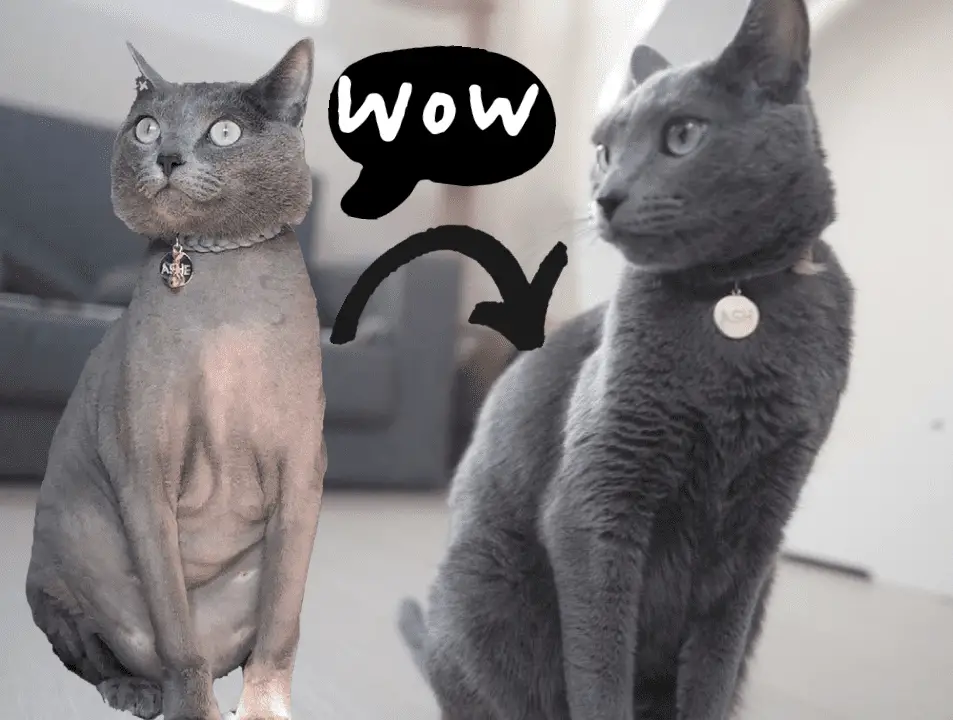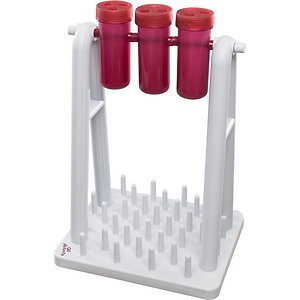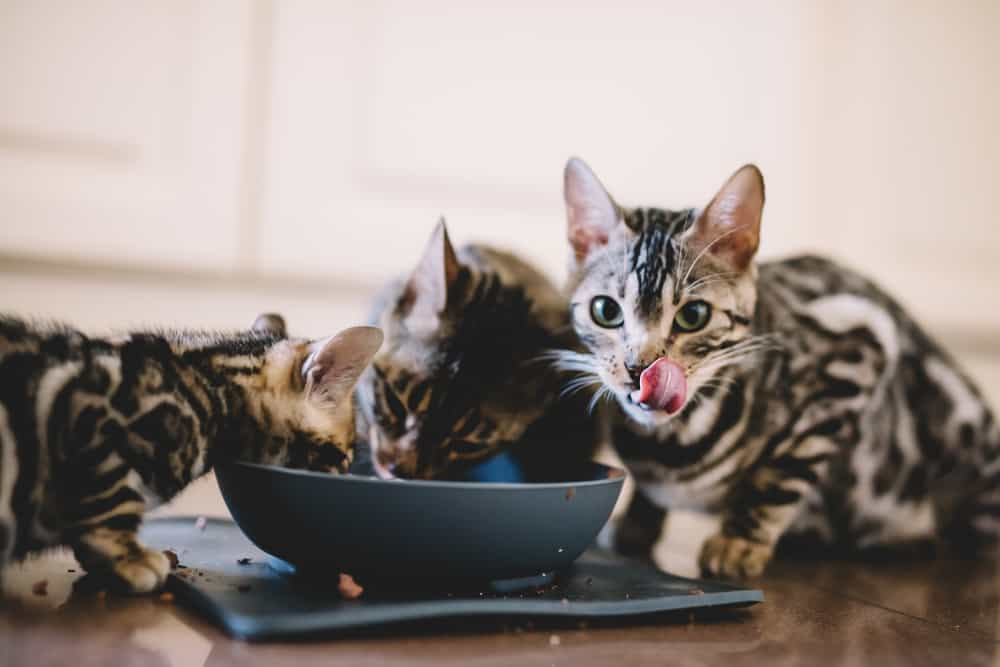If there’s one thing that most cat owners have to deal with, it’s our cat’s weight. There are going to be times in which we feel that our cats are getting a bit too plump for their own good. It’s definitely one of the most important things that cat owners should be able to manage.

Cats get the bad rap of being lazy but considering the environment that they’re in, it does make sense. Everything is handed out and given to them without a second thought. So rather than blaming the cat for just conserving their energy (even though there’s not a situation to conserve it for), it’s up to us to allow our cat to go back to their natural leaner state.
The 3 strategies that are the easiest and most effective ways to get your cat to lose weight are:
- Using puzzle feeders
- Implementing mealtimes
- Leverage your cat’s energy cycle
Cats are efficient creatures, so trying to force them to move and exercise isn’t the way to do it. Understanding how a cat is motivated and use their energy is going to be the best way to allow them to slowly but surely lose the unnecessary weight.
What Are the Risks Associated With Obesity in Cats?
Obesity is one of the biggest risk factors for cats indoors. Overeating coupled with the lack of movement is what causes it and of course, it affects the health of our cats. Sick cats obviously mean more trips to the vet which in addition to veterinary bills, it’s often taxing mentally for both us and our cats.
Overweight/Obese cats can develop:
- Diabetes
- Kidney and Heart Diseases
- Many forms of cancers
- Chronic inflammation of joints or organs
Therefore, keeping your cats a good weight and shape is often more important than spoiling them with food and snacks.
How Fast or Slow Should a Cat Lose Weight?
According to experts and veterinarians, a safe weight loss rate for cats to lose is about 0.5% to 2% of their body weight per week.
Therefore if you have an 11 lbs. (or 5 kg) cat, the cat can lose up to 0.055 lbs. – 0.22 lbs. (or 0.025 kg – 0.1 kg) per week.
In a month, that 5 kg cat can lose up to 0.4 kg maximum.
Similar to any animal that loses weight too quickly, if cats lose their pounds too quickly there can be a lot of deficiencies in their nutrition which can lead to more harm than good. Also, losing weight too quickly increases the chance of fatty liver disease (when the liver cannot break down the fat fast enough, thus leading to liver function impairment or worse).
Therefore, it’s best to take the more sustainable route for weight loss. Something they’re able to do every day that leads them on the path of a healthier weight and lifestyle.
Use Puzzle Feeders to Help Your Cat Lose Weight Sustainably
Puzzle Feeders are sometimes thought about as a novelty for cats but in the wild, cats are not only hunters but are natural foragers. They get into small corners and spots and try to forage for food.
Unfortunately, they don’t really get the chance to do this indoors as us butlers tend to spoil them with their food on a plate or bowl. Watch how fast your cat devours their food – sometimes it doesn’t even last 5 minutes in the bowl depending on how voracious the cat is.
Using puzzle feeders not only slows down their eating pace but also includes these benefits:
- Increased engagement indoors – They’re able to practice and exercise their foraging skills and will often return to their puzzle feeder throughout the day to finish off their food or snacks.
- Prevent devour and vomit eating habits – many cats can’t pace themselves with food in or bowl on a plate, they eat too quickly and vomit quickly after.
- Sustainable weight loss – cats eating in a puzzle feeder exclusively, not only have more proper portions of food but they actually have to move, paw, and hit, to get the food out. Therefore, burning calories in the process.
- Durable, reusable, and lasts for a long time – getting the proper puzzle feeder isn’t hard. They’re one of the best things to get for a cat because it’s usually just a one-time purchase. They can take the brunt of daily use, easy to use, and wash that they last for a long time.
Science Supporting Puzzle Feeders For Cats
In a 2016 study: Food Puzzles for Cats: Feeding for Physical and Emotional Wellbeing. The use of food puzzles was monitored throughout a certain period and used with a select group of indoor cats (of differing ages & breeds) from different home environments (multi-cat homes, single-cat homes, etc.).

After 6 months to a year of implementing the food puzzle treatment/enrichment, many of the concerns initially stated with their cats were either resolved or substantially decreased! Here were the most noticeable changes after a few months:
- 10 – 20% weight loss in 12 months (One case of 32% in 18 months!)
- A decrease in meowing for food and general attention seeking
- Aggression behaviors decreased in frequency and intensity over time
- Less frequency of biting and in some cases – totally stopped!
- Significant decrease in inter-cat tension
- Marking behavior ceasing!
Similar to us humans – making a large change to our habits can be difficult but if we’re able to start with small changes to our lifestyle, it can create big changes if we do it consistently every day.
Recommended Puzzle Feeders For Cat Weight Loss
For most people – I would recommend puzzle feeders that are large and have a lot of different types of ways that our cats can obtain their food. They’re great for multiple cats to use too, just scoop the correct portion for your cats and place it in the puzzle feeder each mealtime.
In my apartment, I have two puzzle feeders to rotate in and out to keep things fresh for the cats since each puzzle feeder is different and offers multiple ways for the cats to obtain their food.
 Trixie Activity Fun Board
Trixie Activity Fun Board
A really great activity/puzzle feeder. Large enough to accommodate multiple cats and has a variety of ways that your cats can play/obtain their food or snacks! Great for all types of cats and promotes slow methodical eating.
 Mad Scientist Turn Around Snack Activity Board
Mad Scientist Turn Around Snack Activity Board
Cats are clever and inquisitive animals, and this interactive toy is designed with just that in mind, offering a variety of ways to play. Start off by placing some treats inside the beakers, and let your cat master the concept of flipping the beakers upside down to release the treats. Then, take it up a notch by adding the included lids with patterned holes, which makes it more difficult to get the treat out. He’ll love the thrill of the hunt and mental stimulation!
Implement Scheduled Mealtimes & Correct Portioning For Cats
I talk about this a lot on my website but it’s something that might not be looked at as an important part of owning a cat. However, when cat owners keep food out for their cats at all times of the day, afraid that they might be hungry – it’s going to do more harm than good.
Even if you choose diet food for your cats – it’s going to have little to no effect if you have no control over their portion sizes or knowledge about how much your cat should be able to eat.
In a cat’s natural wild state, they eat to recoup their energy after a successful hunt but in a constant state of fullness from free-feeding, their energy levels are going to be unpredictable.
Here are the main benefits to scheduled mealtimes:
- Controlling the frequency and amount of food – this is simple, this is to allow us more control on how much our cat is eating in case they’re becoming a bit too plump.
- Predicting energy levels – eating food is all about recouping energy – therefore cats are usually pretty low energy after a meal. Use this to your advantage if you need downtime, during sleep hours, or just busy.
- Fits with a cat’s natural state – a cat in the wild is never full all day. They’re playing, hunting, foraging, and then eating. This allows your cats to be more active and curious.
How Often Should You Feed Your Cat(s)?
So now that we know scheduled meal times are great but how often should you have those mealtimes? Well according to a recent study 2020 study: Daytime Feeding Frequency Affects Hormones and More, it seems that less is more in terms of feeding frequency.
In the study, eight indoor cats under the age of five were fed different feeding programs for a total of three weeks with the same diet and amount being offered. The only thing that varied was the frequency of mealtimes provided throughout the day.
That cats were monitored on their physical activity levels, food intake, and body weight was measured weekly. They also measured each cat’s metabolism through their breath and blood.

Out of all the feeding frequencies the cats that only had one mealtime a day had the best results in terms of regulating their appetite, more nutrients available to them, and had the potential to burn more fat compared to a cat that was feeding multiple times a day.
For the cats that had only one mealtime a day:
- Had higher appetite-regulating hormones – meaning they were more satisfied throughout the day and exhibited fewer food cravings
- Lower fasting respiratory quotient – meaning they were burning more fat stores which helps them maintain a lean body mass
- A large increase in blood amino acids – more protein available to build muscles and regulate body functions
These results show that cats should not be free-fed but should be even cutting back on mealtime frequency too! For years veterinarians have stated that cats should be fed many small meals a day but these findings prove otherwise. Therefore, this is an effective feeding regimen that could support weight loss and a lower fat mass.
Cats in the wild and even big cats engage in intermittent fasting, much like our human ancestors. Fasting until they find a big meal, in which case it’s feasting time until the next one.
This is especially important because many cats lose muscle mass as they age – called sarcopenia. This feeding regimen can help avoid or at least minimize the effects of the disease.
My Recommendation on Frequency & Mealtimes
According to this study, it obviously supports less frequent mealtimes. One mealtime might be ideal for our cats but actually, mealtimes are a great tool to manage our cat’s energy levels so I would recommend 2 mealtimes a day depending on your own schedule. How do mealtimes affect and guide your cat’s energy levels specifically? I wrote an in-depth article about it here.
So for my cats, two big well-portioned meals per day – once in the morning and once at night is probably the best way to go about it. I use to feed my cats 3 meals a day but I felt that 2 meals are more conducive to their lifestyle indoors.
How Much Food Should You Portion Out For Your Cat?
This is going to depend on the age, weight, and physical activity of your cats and how frequent their mealtimes are, however, I put a reference chart below to help you stick to some guidelines when trying to food portion.
| Cat Food Regimen | Expected Time to Finish Food in Bowl/Plate | Expected Time to Finish Food In Puzzle Feeder |
| 3 Meals a Day | 10-30 minutes | 1-2 hours |
| 2 Meals a Day | 30 minutes – 1 hour | 2-4 hours |
| 1 Meal a Day | 2-3 hours | 3-5 hours |
If they take longer than the recommended time, then decrease the amount of food that you give them next time. If they finish the food too quickly, then give them a bit more food at the next mealtime.
Using a Cat’s Play Cycle to Maximize Energy Expenditure
If you observe your cats throughout the day, they will probably follow this energy cycle below. This is an important concept to understand as it allows cat owners to predict and guide their cat’s energy levels throughout the day.

For example from highest energy to lowest energy:
- Playtime Phase (highest energy) – when cats feel hungry they are more motivated to participate in hunting activities.
- Catching Phase – signals the end of playtime for the cats. In the wild, it is estimated cats will be successful only about 40-50% of the time. Therefore, allowing them to catch their toy or “prey” at the end of the play session lets them feel “satisfied” instinctually. Let your cat play around with their prey or toy once they have caught it for a few minutes.
- Eating Phase – obvious but important. Cats eat their prey after a hunt. Therefore after a play session, it’s the best time to feed them their scheduled meal.
- Groom – the wind-down phase. They’re approaching their lowest energy state.
- Sleep – the last but most important phase. After everything is finished, they will sleep and regain their energy for the next “hunt” or play session and the cycle is complete.

Now, why is knowing this cycle incredibly important?
Well for a lot of reasons:
- Maximal energy expenditure – cats will typically move more when they’re hungry. So playing when they’re mostly on an empty stomach before their scheduled mealtimes is ideal.
- Cements a routine – when a cat goes through this cycle. They start to train their energy internal clock to fit when they’re the most active. It allows cat owners to predict their cat’s activity throughout the day.
- Great tool for keeping cats out of trouble- whenever you want a cat to wind down and not be so active, go through the cycle and watch them go through each phase. For example, many people want to sleep at a certain time without their cats bothering them all the time throughout the night. Go through the cycle with your cats before bedtime and reclaim your beauty sleep!
Other Effective Ways to Manage a Cat’s Weight
Every owner has their own strategies about how to manage their cat’s weight. These are some other ways to help your cat lose weight:
- Add water to your cat’s wet food to be more satiating and hydrating
- Catification of your environment to allow more ways for your cats to jump, climb, and navigate their space
- Invest in a cat wheel. Cat wheels are super passive items that cats can jump on and off whenever they want!
Leave a comment if you have your own strategies that you’ve implemented to help your cat lose weight!

Hey TN, great channel and website. I have a question for you regarding meal times.
I have a crazy bengal and currently have him on a feeding schedule of 4 times a day and wanted to switch to two how do I transition.
Thanks in advance.
Thanks for your comment! I think the key is to decrease it gradually. Since you’re starting from 4, go to 3 meals a day (increase the portions). After he’s used to that, go to 2 meals a day (increase the portions a little bit). I’m glad you’ve been enjoying my content!
Love your blog and was wondering for the puzzle feeders if you put food for all your cats in one puzzle feeder, and if so how do you not worry about one cat monopolizing the feeder/eating more than they should? Thanks for the help in advance!